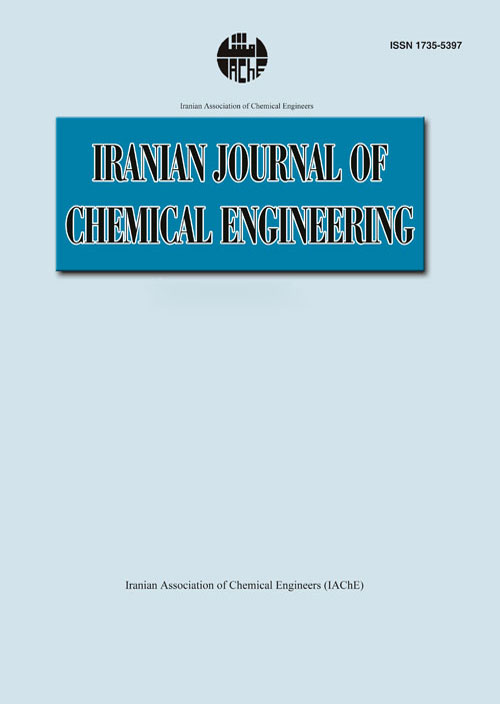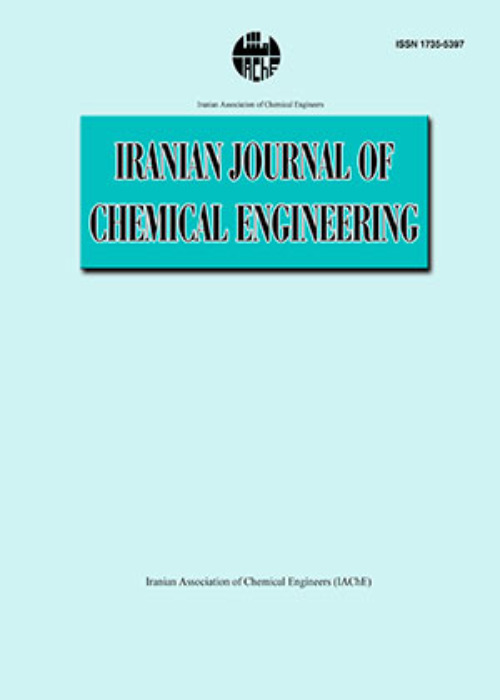فهرست مطالب

Iranian journal of chemical engineering
Volume:17 Issue: 1, Summer 2020
- تاریخ انتشار: 1399/06/11
- تعداد عناوین: 6
-
-
Pages 3-36
The shell of walnut fruit is an agricultural byproduct generated in considerable amounts upon the processing of fruit to obtain its valuable kernel. Walnut is recognized as an appreciated tree nut belonging to the Juglandaceae family. The fruit is mainly composed of a kernel, seed coat, shell, and husk. In recent years, the shell portion of walnut fruit has been widely used in the development of different high–value materials. In this regard, high carbon and low ash contents of the walnut shell (WS) make it a suitable material and inexpensive waste agricultural product for the activated carbon (AC) preparation. In this review, recent developments in the preparation of AC from the shell of walnut fruit and the characterization methods are highlighted. Additionally, the applications of AC mainly in the removal of different hazardous materials such as heavy metals (HMs) ions, dyes as well as pharmaceuticals and other dangerous materials are comprehensively discussed.
Keywords: Activated carbon, By-products, Fruit, SHELL, Walnut (Juglans regia L.) -
Pages 37-46
The gas antisolvent (GAS) process has been employed for the pharmaceutical micronization. Ampicillin was dissolved in an organic solvent and carbon dioxide as an antisolvent was injected into the solution, consequently, some volume expansion and sharp reduction in liquid solvent power were shown. The particles in GAS process are not seen in any operating conditions. The thermodynamic modeling of GAS can evaluate the operating conditions. In this project, the effect of solvents on the optimal thermodynamic conditions of the binary system (CO2, solvent) and ternary system (CO2, solvent, ampicillin) were investigated. The relative change in the molar volume in different solvents (ethanol, 1-propanol, 1-butanol, and 1-pentanol) was studied for the determination of the optimum operating conditions. The combination of the Peng-Robinson EOS and Vidal and Michelsen mixing rule (LCVM) was selected to determine the optimum operating condition of the GAS process. The effect of solvents on the minimum pressure was investigated. The calculated Pmin was 70, 70.86, 72.2 and 73.4 bar for ethanol, 1-propanol, 1-butanol, and 1-pantanol at, 308.15 K respectively. According to modeling results, when the molecular weight of the solvent was increased, the value of Pmin was increased.
Keywords: Thermodynamic Modeling, GAS process, Solvent, Ampicillin, Carbon dioxide -
Pages 47-64In this study, hydrodynamic characteristics such as gas holdup (ε), liquid phase velocity, and mass transfer coefficient (kLa) for air-diesel system were modeled for bubble column (BCR), airlift (ALR), and airlift with the net draft tube (ALR-NDT) reactors at different superficial gas velocities ranging from 0.008 to 0.085 m s-1. A 3D two-fluid Eulerian-Eulerian model was developed using computational fluid dynamic (CFD) technique to model the three configurations of column reactors and predict the hydrodynamic parameters. The results of 3D-CFD modeling showed a good agreement with the experimental data where average error was less than 14 and 9% for ε and kLa, respectively. Although the vortex occurred in BCR and ALR at high gas velocities, however optimum liquid and gas circulation and distribution observed in ALR-NDT. Furthermore, the formation of dead zone (kLa = 0) in the reactors was studied, and the results revealed that ALR-NDT has a lower volume of dead zones (about 8%) in comparison with BCR and ALR. In order to reduce the dead zone in BCR and ALR systems, the location of gas diffuser and draft tube were investigated. The dead zone was decreased by 12% with shifting of gas diffuser to the bottom of the BCR. Also, by increasing the distance of gas diffuser from draft tube, the dead zone was decreased by 40% specifically near the walls of ALR. Meanwhile, the simultaneous shifting of gas diffuser and draft tube to lower position in ALR had no effect on dead zone formation and its distribution.Keywords: Hydrodynamics, Multiphase reactor, Gas flow velocity, Mass Transfer Coefficient, Gas holdup, Dead zones, Net Draft Tube
-
Pages 65-78In this study, a comprehensive model was proposed in order to predict the tensile strength of nanocomposites considering the effects of the random orientation of nanoparticles, interphase properties and also the inevitable aggregation/agglomeration phenomenon. The model was structured based on the nanoparticle shape (e. g. platelet, cylindrical and spherical) so it could perfectly demonstrate the random orientation. It was revealed that neglecting the aggregation/agglomeration of the nanoparticles ( ) drastically rises the prediction error to about 12% while considering decreased the error to about 7-9% for samples with low content of nanoparticles (< 0.5 Vol.). Moreover, the model was completely capable of characterizing the polymer/particle interphase regardless of the polymer type and the nanoparticles shape. Model verification was accomplished by comparing its predictions with the tensile test results of the prepared nanocomposite samples of different compositions (Polystyrene/Silica, Polystyrene/Graphene Oxide and Polystyrene/Carbon nano-tubes). Also, the samples were subjected to TEM in order to qualitatively evaluate the behavior of the different shaped nanoparticles in the polystyrene matrix.Keywords: Polymer nanocomposites, tensile strength, Random orientation, Polymer, Particle interphase, Aggregation, Agglomeration
-
Pages 79-89Stimuli-responsive amphiphilic core-shell polymer nanoparticles are an important category of smart materials which have been studied due to their advantages of changing of physical or chemical properties in response of stimuli. In this study, poly[2(dimethylamino)ethyl methacrylate] (PDMAEMA) as hydrophilic core with hydrophobic layer polystyrene (PS) as shell were synthesized by seeded emulsion polymerization to achieve dual-sensitive core-shell nanoparticle (CSNP). Temperature- and CO2- responsive CSNPs were investigated as two important smart behaviors. The CSNPs were characterized by dynamic light scattering (DLS) and scanning electron microscopy (SEM). In addition, two essential parameters including the polymerization conversion and stability of polymer latexes were investigated. Obtained results showed that hydrophilicity-hydrophobicity balance of the latex nanoparticles could be changed by variation of temperature and induction of CO2 gas flow, as a result of temperature- and CO2-responsivities of the PDMAEMA core. The particle size of CSNP was increased when the temperature rised above the lower critical solution temperature (LCST) of the PDMAEMA. It is due to the formation of hydrogen bonds between water molecules and tertiary amine group which lead to swell in PDMAEMA below LCST, and deswelling from water above LCST of the PDMAEMA. Furthermore, the size of the latex nanoparticles was increased from 696 nm to 853 nm after CO2-bubbling which led to increase hydrophilicity or water swelling of PDMAEMA in latex nanoparticles.Keywords: Seeded emulsion, Amphiphilic nanoparticle, PDMAEMA-PS, stimuli-responsive
-
Pages 90-102Water and solid effective diffusivities and shrinkage were correlated for finite hollow cylinder-shaped apple samples during the candying operation in the osmotic solution. Experiments were conducted in the sucrose solution as an osmotic agent at different temperatures (i.e., 40, 50, and 60 °C) and at a constant concentration of 55 °Brix. The effective diffusivities of water and solid were calculated by fitting the water loss and solid uptake experimental data to Fick’s second law and fractional calculus method, considering the shrinkage of the samples during the candying process. The obtained results exhibited that the volume of the apples reduced linearly by increasing the water loss. For above conditions of the candying process, water effective diffusivities with Fick second law were determined in the range of 3.7×10−10 m2/s–8.73×10−10 m2/s, and those with fractional calculus method were in the range of 2.75×10−10 m2/s–6.98×10−10 m2/s. The results indicated that the coefficient of determination for the fractional calculus method was more than the coefficient of determination for the Fick model. The value of the empirical parameter α for the Non-Fickian diffusion model was always higher than unity, meaning that the dehydration process had a super-diffusive mechanism.Keywords: Shrinkage, Finite hollow cylinder, Diffusion phenomena, Fractional calculus, Anomalous diffusion models


